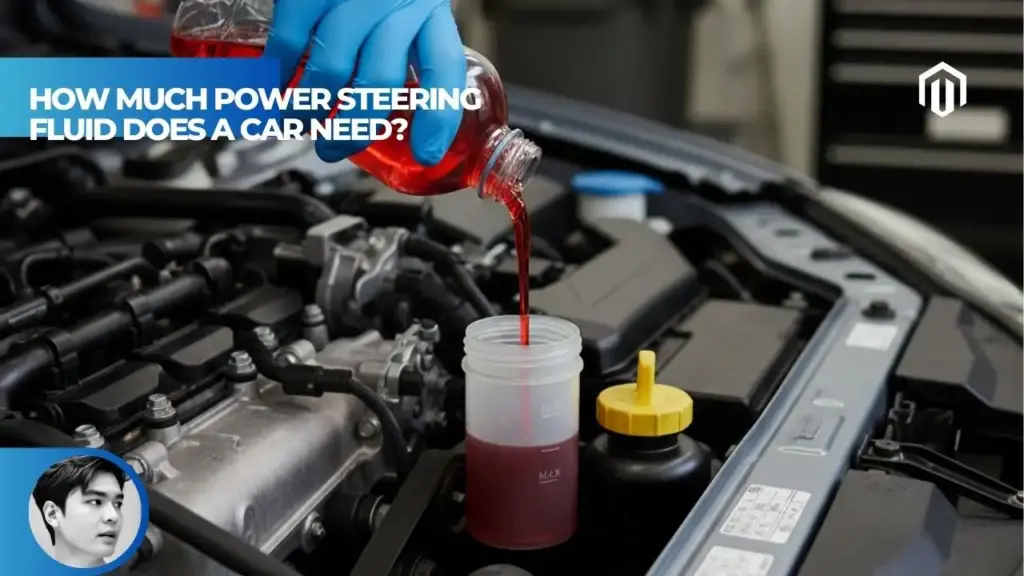You may also like:
Most vehicles require 0.5 to 1 liter (16.9-33.8 fluid ounces) for a complete reservoir fill, with total system capacity ranging from 1 to 2 quarts. For simple top-offs, you’ll typically need just a few ounces to reach the MAX line, while a complete flush requires approximately 2 quarts to properly clean and refill the entire power steering system.

Power Steering Fluid Capacity Overview
Understanding your vehicle’s power steering fluid capacity is essential for proper maintenance and preventing costly repairs. Modern power steering systems vary significantly in size and design, affecting how much fluid they require for optimal operation.
Average Power Steering Fluid Reservoir Capacity
The average power steering fluid reservoir holds between 16.9 and 33.8 fluid ounces (0.5 to 1 liter), though this represents only the visible portion of the system[1]. Most passenger vehicles fall within this range, with compact cars trending toward the lower end and larger vehicles requiring more. The reservoir itself typically accounts for about 40-50% of the total system capacity.
According to automotive engineers, reservoir size is designed with expansion in mind. When power steering fluid heats up during operation, it can expand by 5-10%, requiring adequate headspace to prevent overflow[2]. This explains why you should never fill beyond the MAX line, even if the reservoir appears to have room.
How Many Ounces of Power Steering Fluid Does My Car Take
Your specific vehicle’s fluid requirement depends on several factors including engine size, steering system type, and manufacturer design. Compact cars typically need 20-24 ounces total, while full-size trucks and SUVs may require 32-48 ounces for the complete system[1]. Luxury vehicles with advanced steering systems, such as the 2025 BMW 5 Series, often require specialized fluids and precise quantities.
Here’s a general breakdown by vehicle type:
| Vehicle Category | Reservoir Capacity | Total System Capacity |
|---|---|---|
| Compact Cars | 12-16 oz | 20-28 oz |
| Mid-Size Sedans | 16-20 oz | 28-36 oz |
| SUVs/Crossovers | 20-28 oz | 36-48 oz |
| Full-Size Trucks | 24-32 oz | 40-64 oz |
Power Steering System Capacity (Rack and Pinion)
Rack and pinion steering systems, used in 95% of modern vehicles, typically hold more fluid than older recirculating ball systems[3]. The complete system includes the reservoir, pump, high-pressure lines, steering rack, and return lines. Together, these components can hold 1 to 2 quarts of fluid, with the steering rack itself containing about 40% of the total volume.
The power steering pump alone holds approximately 8-12 ounces, while the connecting lines and cooler (if equipped) account for another 4-8 ounces. Understanding this distribution helps explain why a simple reservoir top-off might not address issues stemming from low fluid throughout the entire system.
Is a Quart of Power Steering Fluid Enough?
For most maintenance tasks, one quart is sufficient for top-offs and minor servicing, but may fall short for complete system work[1]. A single quart bottle covers routine top-offs for several years under normal conditions. However, if you’re addressing a leak or performing component replacement, you’ll likely need additional fluid.
Autvex recommends purchasing two quarts when planning a flush or major repair. Having extra fluid on hand prevents mid-job trips to the parts store and ensures you can properly bleed the system without running short. Unopened power steering fluid has a shelf life of 3-5 years, making it practical to keep spare fluid for future needs.
Amount of Fluid Needed for Different Procedures
Different maintenance procedures require varying amounts of power steering fluid. Understanding these distinctions helps you purchase the right quantity and avoid waste or shortages during service.
How Much Fluid for a Power Steering Flush
A complete power steering flush requires 2 to 2.5 quarts for most vehicles, though some larger trucks may need up to 3 quarts[2]. This amount accounts for flushing old fluid from all components, not just draining the reservoir. The process involves cycling clean fluid through the system multiple times to remove contaminants and degraded fluid.
Professional shops typically use a flush machine that exchanges fluid while the engine runs, ensuring complete system cleaning. DIY methods using the “turkey baster method” might require slightly more fluid due to less efficient exchange rates. Budget for at least 2.5 quarts when performing a home flush to ensure adequate supply.
Power Steering Flush vs Simple Top-Off
The fluid requirements differ dramatically between these procedures. A simple top-off needs 2-8 ounces, while a complete flush requires 32-80 ounces[4]. Top-offs address minor fluid loss from normal seepage or small leaks, requiring just enough fluid to restore the proper level in the reservoir.
Consider these distinctions:
- Top-off: Quick 5-minute procedure, addresses immediate need
- Partial drain/fill: Removes reservoir fluid only, needs 16-24 ounces
- Complete flush: Full system service, requires 2+ quarts
- Component replacement: Varies by part, typically needs 1-2 quarts
Amount of Power Steering Fluid to Add (Top-Off)
When topping off power steering fluid, most vehicles need 4-8 ounces to go from MIN to MAX on the dipstick[1]. Never add fluid based solely on time intervals—always check the current level first. The difference between MIN and MAX lines typically represents 25-30% of reservoir capacity.
Add fluid in small increments of 2-3 ounces, checking the level after each addition. Power steering fluid expands significantly when warm, so checking after alignment services or extended driving may show different levels than when cold. Always check fluid level with the engine off and on level ground for accuracy.
Procedure for Power Steering Fluid Change
The standard fluid change procedure requires specific amounts at each step. Initial reservoir draining removes 12-20 ounces, followed by system purging using another 20-30 ounces[2]. The final fill and bleed process needs an additional 10-15 ounces to account for air displacement and level adjustment.
Step-by-step fluid requirements:
- Initial drain: 12-20 oz removed
- First refill: 16-20 oz added
- System cycling: 8-12 oz additional
- Final top-off: 4-8 oz for proper level
- Reserve amount: 4-6 oz for post-service adjustment
Vehicle-Specific Power Steering Fluid Capacities
Different makes and models have unique fluid requirements based on their steering system design. Knowing your vehicle’s specific needs prevents under or overfilling, both of which can cause steering problems.
Power Steering Fluid Capacity by Make and Model
Vehicle manufacturers specify exact capacities in owner’s manuals, but general patterns exist across brands. Japanese vehicles typically use less fluid (0.8-1.2 quarts total), while American trucks often require more (1.5-2.5 quarts)[3]. European luxury vehicles like Audi Q5 and BMW X3 may specify synthetic fluids with precise fill quantities.
Common brand tendencies:
- Toyota/Honda: 0.9-1.1 quarts, often accept ATF
- Ford/Chevy: 1.2-1.8 quarts, brand-specific fluids
- BMW/Mercedes: 1.0-1.4 quarts, synthetic required
- Stellantis (Chrysler): 1.1-1.5 quarts, ATF+4 common
Power Steering Fluid Capacity Ford F150
The Ford F-150, America’s best-selling truck, requires 1.5 to 2 quarts for a complete system fill, depending on engine and model year[3]. 2020-2025 models with the 3.5L EcoBoost need approximately 1.7 quarts, while older V8 models may require up to 2.1 quarts. Ford specifies Mercon V or Mercon LV fluid for most F-150 applications.
The F-150’s larger capacity stems from its heavy-duty steering components designed for towing and hauling. The reservoir alone holds about 20 ounces, with the steering gear box accounting for another 24-28 ounces. Always consult your specific year’s manual, as Ford has updated specifications several times.
Power Steering Fluid Capacity Honda Civic
Honda Civics require approximately 1 quart (32 ounces) for complete system capacity, with the reservoir holding about 13 ounces[1]. Honda specifically requires Honda PSF or Honda-compatible fluid, warning against using generic power steering fluids that can damage seals. The 2022-2025 Civic models maintain this same capacity despite design updates.
Interestingly, older Civics (pre-2006) accepted standard ATF, but modern models require Honda’s proprietary formula. A simple top-off typically needs 3-5 ounces, while a complete flush requires 1.5 quarts to ensure thorough cleaning. The compact design means precise filling is crucial—even slight overfilling can cause foaming issues.
Power Steering Fluid Capacity Chevy Silverado
The Chevy Silverado’s power steering system holds 1.8 to 2.3 quarts depending on configuration, with HD models requiring the higher amount[3]. The 1500 series typically needs 1.8 quarts, while 2500HD and 3500HD models with hydroboost brake systems require additional fluid capacity. GM recommends Power Steering Fluid (GM Part No. 89021184) or equivalent meeting GM specifications.
These trucks feature larger reservoirs (24-28 ounces) to handle the demands of heavy towing and commercial use. The additional capacity also provides better heat dissipation during extended low-speed maneuvering common in work applications. When comparing towing vehicles, consider that larger steering fluid capacity often indicates more robust steering components.
Power Steering Fluid Capacity Based on Vehicle Size
Vehicle size generally correlates with fluid capacity, though engineering design plays a significant role. Subcompact cars need 0.7-0.9 quarts, while heavy-duty trucks may require 2.5+ quarts[2]. However, some performance vehicles have oversized systems despite compact dimensions, and certain luxury SUVs use efficient designs requiring less fluid than expected.
Size-based capacity guidelines:
- Subcompact (Nissan Versa, Honda Fit): 24-30 oz
- Compact (Toyota Corolla, Mazda3): 28-34 oz
- Mid-size (Honda Accord, Toyota Camry): 32-40 oz
- Full-size (Chrysler 300, Chevrolet Impala): 38-48 oz
- Compact SUV (Honda CR-V, Toyota RAV4): 34-42 oz
- Full-size SUV (Tahoe, Expedition): 48-64 oz

How to Check and Add Power Steering Fluid
Proper checking and filling procedures ensure accurate fluid levels and prevent system damage. Following correct techniques prevents common mistakes that lead to steering problems.
How to Check Power Steering Fluid Level
Checking power steering fluid requires specific conditions for accuracy. Always check with the engine off and the vehicle on level ground after the system has cooled for at least 10 minutes[5]. Most vehicles have either a transparent reservoir with MIN/MAX markings or a dipstick attached to the reservoir cap.
For dipstick-equipped systems, remove the cap, wipe the dipstick clean, fully reinsert it, then remove again to check the level. The fluid should appear between the MIN and MAX marks—closer to MAX is ideal. Transparent reservoirs allow visual inspection without opening the system, reducing contamination risk.
How to Correctly Top Off Power Steering Fluid
Topping off requires patience and precision to avoid overfilling. Add fluid in 2-ounce increments, allowing 30 seconds between additions for the fluid to settle[5]. Use a funnel to prevent spills, as power steering fluid can damage paint and rubber components if left on surfaces.
Proper top-off technique:
- Clean around the reservoir cap before opening
- Check current level and fluid condition
- Add appropriate fluid type slowly
- Recheck level after each small addition
- Stop at MAX line—never exceed
- Run engine and recheck after cycling steering
Filling Power Steering Reservoir
The reservoir filling process differs between routine top-offs and post-service fills. After component replacement or system bleeding, the reservoir level will drop as fluid fills empty spaces. Initial filling should reach the MAX line, followed by system cycling and refilling as needed[2].
Autvex technicians recommend having an assistant turn the steering wheel lock-to-lock while you monitor fluid level during initial fills. This prevents air pockets and ensures complete filling. Never start the engine with the reservoir less than half full, as pump damage can occur within seconds of dry running.
Level Markers on Power Steering Reservoir
Understanding reservoir markings prevents filling errors. Most reservoirs feature HOT and COLD sections with separate MIN/MAX indicators for each temperature range[5]. The hot range applies after driving, while cold markings indicate proper level for cold starts.
Some vehicles use single markers assuming room-temperature checking. European vehicles often mark levels in millimeters from the cap bottom rather than MIN/MAX designations. When unclear, filling to 3/4 of visible reservoir capacity provides safe operation without overflow risk. Always reference your owner’s manual for specific marking interpretations.
When and Why to Add Power Steering Fluid
Recognizing when fluid addition is necessary prevents damage and maintains steering performance. Understanding the underlying causes helps address root problems rather than just symptoms.
When to Add More Power Steering Fluid
Add power steering fluid when the level drops below the MIN mark or when experiencing steering symptoms. Monthly checks are recommended, with immediate attention needed if you notice steering changes[6]. Normal fluid loss of 1-2 ounces annually is acceptable, but frequent top-offs indicate problems requiring investigation.
Warning signs requiring fluid addition:
- Visible fluid below MIN line
- Whining noise when turning
- Increased steering effort
- Foamy or aerated fluid appearance
- Steering wheel vibration at idle
- Slow steering response
How Often to Change Power Steering Fluid
Most manufacturers recommend power steering fluid changes every 50,000-75,000 miles or 3-5 years, though severe conditions may require more frequent service[6]. Unlike engine oil, power steering fluid doesn’t combust, but it still degrades from heat, contamination, and moisture absorption over time.
Severe service conditions requiring 30,000-mile intervals include:
- Frequent towing or hauling
- Regular off-road driving
- Commercial or delivery use
- Hot climate operation
- Stop-and-go city driving
The high-mileage vehicles may benefit from more frequent changes to prevent pump wear.
Why Is My Power Steering Fluid Low
Low fluid typically indicates a leak somewhere in the system, as power steering fluid doesn’t “burn off” like engine oil. Common leak points include the pump shaft seal, rack end seals, and hose connections[3]. Age-related seal deterioration accounts for most leaks, particularly in vehicles over 100,000 miles.
Internal leaks can occur within the rack, allowing fluid to bypass seals without external evidence. This condition causes fluid aeration and requires rack replacement. Small external leaks might only appear as dampness or slight residue, making them difficult to identify without careful inspection.
Causes of Low Power Steering Fluid
Multiple factors contribute to fluid loss beyond simple leaks. Normal seepage through seals accounts for minimal loss, while component wear accelerates fluid consumption[3]. Temperature extremes cause seal contraction and expansion, potentially creating temporary leak paths.
Primary causes of fluid loss:
- Pump seal failure: Age and heat degradation
- Rack seal wear: Contamination and normal use
- Hose deterioration: Cracking from heat cycles
- Fitting looseness: Vibration-induced backing out
- Reservoir crack: Impact or stress damage
- Cooler leaks: Corrosion in integrated coolers
Power Steering Fluid Leak Symptoms
Recognizing leak symptoms enables early intervention before major component damage occurs. Puddles under the vehicle are obvious indicators, but many leaks present subtler signs[6]. Power steering fluid typically appears reddish or brown and has a distinctive petroleum smell different from other automotive fluids.
Early leak indicators include:
- Fluid spots on garage floor (red/brown color)
- Wet appearance on pump or rack boots
- Burning smell from fluid on hot exhaust
- Gradual increase in top-off frequency
- Steering noise developing over time
- Visible wetness along hoses
Check for leaks with the engine running and someone turning the wheel, as pressure increases can reveal otherwise hidden leaks.
Power Steering Fluid Types and Compatibility
Using the correct fluid type is crucial for system longevity and performance. Wrong fluid selection can cause immediate damage or accelerated wear.
Difference Between Power Steering Fluid Types
Three main categories of power steering fluid exist: conventional petroleum-based, synthetic, and automatic transmission fluid (ATF)[7]. Each type has specific properties suited to different systems. Conventional fluids cost less but may require more frequent changes, while synthetics offer superior temperature stability and longevity.
Key differences include:
| Fluid Type | Viscosity Range | Temperature Rating | Typical Cost | Change Interval |
|---|---|---|---|---|
| Conventional PSF | Medium | -30°F to 250°F | $8-12/qt | 50,000 miles |
| Synthetic PSF | Wide | -50°F to 300°F | $15-25/qt | 75,000 miles |
| ATF (Dexron/Mercon) | Medium-Low | -40°F to 275°F | $6-10/qt | 50,000 miles |
What Happens If I Use the Wrong Power Steering Fluid
Using incorrect fluid can cause seal swelling or shrinkage, leading to leaks within 1,000-5,000 miles[7]. Modern systems designed for specific fluids rely on precise viscosity and additive packages. Wrong fluid may provide immediate function but causes accelerated wear, noise, and eventual failure.
Consequences of wrong fluid use:
- Seal damage: Incompatible additives attack rubber
- Pump wear: Incorrect viscosity increases friction
- Foaming: Wrong anti-foam additives cause aeration
- Corrosion: Missing corrosion inhibitors damage components
- Performance loss: Viscosity mismatch affects assist levels
If wrong fluid is added accidentally, flush the system immediately to minimize damage.
Mixing Power Steering Fluids
While emergency mixing might be necessary, different fluid types should never be intentionally mixed for long-term use[7]. Mixing conventional and synthetic fluids reduces the synthetic’s benefits while potentially creating compatibility issues. ATF mixed with standard power steering fluid can alter viscosity beyond acceptable ranges.
In emergencies, adding a small amount (less than 20%) of different but compatible fluid allows you to reach a service facility. However, schedule a complete flush within 500 miles to prevent long-term damage. Document any emergency mixing for your mechanic’s reference.
Power Steering Pump Replacement Fluid Amount
Pump replacement requires careful attention to fluid quantity, as the new pump arrives empty. Plan for 1.5 to 2 times normal capacity to account for initial filling, bleeding, and level adjustment[2]. New pumps often require specific break-in procedures including gradual fluid introduction and careful air purging.
The replacement process typically uses:
- Initial pump priming: 8-12 oz
- System filling: 20-32 oz
- Bleeding process: 8-16 oz additional
- Final adjustment: 4-8 oz
- Total required: 40-68 oz (1.25-2.1 quarts)
Professional shops often use vacuum filling to minimize air introduction during pump installation, reducing total fluid needs.

Key Takeaways
- Most vehicles need 0.5-1 liter in the reservoir with 1-2 quarts total system capacity
- Top-offs require just 2-8 ounces while complete flushes need approximately 2 quarts
- Check fluid monthly and maintain levels between MIN and MAX markers
- Never exceed the MAX line as fluid expands when heated by 5-10%
- Use only specified fluid types to prevent seal damage and system failure
- Flush every 50,000-75,000 miles or when fluid appears dark or contaminated
- Address leaks promptly as low fluid causes pump damage and steering loss
Decision Path / Next Steps
After understanding your vehicle’s power steering fluid requirements, take immediate action to ensure proper system maintenance. Start by locating your owner’s manual to identify the exact fluid type and capacity specifications for your vehicle. If the manual is unavailable, check the reservoir cap for fluid type information or consult Autvex’s vehicle database for specifications.
Inspect your current fluid level and condition with the engine off and vehicle on level ground. Look for proper level between MIN and MAX markers and assess fluid color—clean fluid appears clear to light amber, while dark or opaque fluid indicates contamination. If topping off, purchase one quart of the specified fluid type; for flushes, buy two quarts to ensure adequate supply.
For immediate top-off needs, add fluid slowly in 2-ounce increments, checking level frequently. Never exceed the MAX line, remembering that fluid expands when warm. If you’re planning to buy a car, check the power steering fluid condition as part of your pre-purchase inspection.
Schedule a professional flush if your fluid appears contaminated or if you’re approaching the 50,000-75,000 mile service interval. Budget $120-200 for professional service or $25-40 for DIY supplies. Address any leaks before adding new fluid—temporary fixes waste money and risk pump damage.
For vehicles with transmission or steering malfunctions, verify fluid levels first as low power steering fluid can trigger warning lights and affect other systems. Modern vehicles with electrohydraulic steering may have different requirements, so confirm your system type before service.
Document all fluid additions and services in your maintenance log, noting date, mileage, and amount added. This information proves valuable for warranty claims and helps establish patterns indicating developing problems. Regular power steering maintenance extends component life and maintains the precise steering feel that ensures safe, confident driving.
Frequently Asked Questions
How do I know if my power steering fluid is low?
Check for difficulty steering, whining noises when turning, or visible fluid level below the MIN line on the reservoir[5]. The steering wheel may also feel stiff or jerky, especially during low-speed maneuvers or parking.
Can I just top off my power steering fluid?
Yes, if the fluid is clean and only slightly low[1]. For dirty or contaminated fluid showing dark color or debris, a complete flush is recommended to prevent system damage and restore proper operation.
How much does a bottle of power steering fluid cost?
A quart bottle typically costs $8-15 for standard fluid, while synthetic or specialty fluids range from $15-25 per quart[4]. Bulk purchases or house brands offer savings for routine maintenance.
What kind of power steering fluid does my car take?
Check your owner’s manual or the cap on the reservoir for specifications[3]. Common types include ATF, synthetic power steering fluid, and manufacturer-specific formulations. Never assume universal compatibility.
Is it okay to use universal power steering fluid?
Generally yes for older vehicles, but modern cars often require specific fluid types[7]. Always verify compatibility with your vehicle’s requirements, as universal fluids may not meet all manufacturer specifications.
How much fluid is needed for a full power steering flush?
Approximately 2 quarts for most vehicles, though some larger trucks may require up to 3 quarts for a complete system flush[2]. Buy extra to ensure adequate supply during the bleeding process.
How often should power steering fluid be changed?
Most manufacturers recommend changing every 50,000-75,000 miles or 3-5 years, but check your owner’s manual for specific intervals[6]. Severe service conditions may require more frequent changes.
What are the signs of a power steering fluid leak?
Puddles under the car (red or brown fluid), dropping fluid levels, whining pump noise, and difficulty steering indicate potential leaks[3]. Check for wetness around the pump, rack boots, and hose connections.
What happens if you overfill the power steering fluid reservoir?
Overfilling causes fluid to foam and overflow when hot, potentially damaging seals, causing leaks, or reducing steering assist effectiveness[5]. Excess fluid can also blow out through the reservoir cap under pressure.
Where is the power steering fluid reservoir located?
Typically near the engine belt area, marked with a steering wheel symbol on the cap[1]. It’s usually a translucent plastic container with level markings or has a dipstick attached to the cap.
Can I use ATF (Automatic Transmission Fluid) instead of power steering fluid?
Some vehicles accept ATF, particularly older models, but verify with your manual first[7]. Using wrong fluid can damage seals and pumps. Many manufacturers now specify against ATF use in power steering systems.
Does a car lose power steering fluid over time?
Minimal fluid loss is normal over years, but frequent top-offs indicate a leak requiring inspection and repair[6]. Annual loss exceeding 4 ounces suggests system problems needing attention.
References
- Bob Is The Oil Guy Forums. (2025). Fluid Capacity of a typical car’s power steering. bobistheoilguy.com. Retrieved from https://autvex.com/how-much-power-steering-fluid-does-a-car-need
- AutoNation Mobile Service. (2025). What Does a Power Steering Flush & Fluid Replacement Cost? autonationmobileservice.com. Retrieved from https://autvex.com/how-much-power-steering-fluid-does-a-car-need
- UTI. (2021). What Is Power Steering Fluid? uti.edu. Retrieved from https://autvex.com/how-much-power-steering-fluid-does-a-car-need
- Chapel Hill Tire. (2020). Do I Need a Power Steering Fluid Flush? chapelhilltire.com. Retrieved from https://autvex.com/how-much-power-steering-fluid-does-a-car-need
- AMSOIL. (2022). How to Check Power Steering Fluid (and When to Change it). blog.amsoil.com. Retrieved from https://autvex.com/how-much-power-steering-fluid-does-a-car-need
- Sweet Manufacturing. (2025). How Often to Change Power Steering Fluid. sweetmanufacturing.com. Retrieved from https://autvex.com/how-much-power-steering-fluid-does-a-car-need
- AutoZone. (2025). Transmission Fluid Vs Power Steering Fluid. autozone.com. Retrieved from https://autvex.com/how-much-power-steering-fluid-does-a-car-need

I am a senior automotive analyst at Autvex. Expert vehicle evaluations, in-depth reviews, and objective analysis helping readers make informed automotive decisions with years of industry experience.









